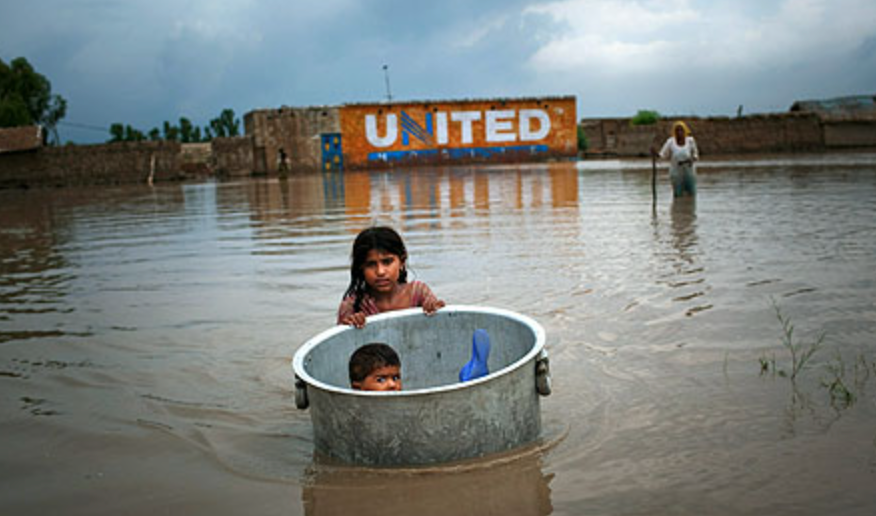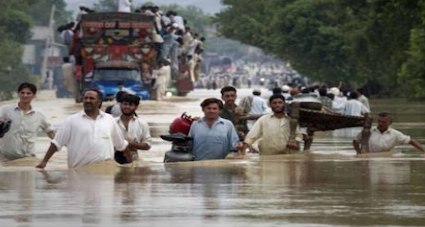Prime Minister Narendra Modi expressed condolences to the families of victims of floods that have devastated Pakistan during the past fortnight or so. He took to Twitter for expressing his thoughts and said: Saddened to see the devastation caused by the floods in Pakistan. We extend our heartfelt condolences to the families of the victims, the injured and all those affected by this natural calamity and hope for an early restoration of normalcy.
His words on Monday about hope for “an early restoration of normalcy’’ seem unrealistic though as weather predictions have said that the rains in Pakistan may last till September end. That means even if it doesn’t rain for some days, the receding waters will get replaced again, and again. As such, the present miseries of the affected Pakistanis may continue for at least a month more. Therefore, the full extent of the damage to infrastructure will start becoming clear in mid-October only. Relief efforts from “friendly countries’’ may get more streamlined during this period as other nations seem to be waking up to Pakistan’s realities.
The statistics regarding damage due to floods are stark and gloomy, and by no means comprehensive as these are likely to get updated again and again. By Monday evening, according to newspaper Dawn and some TV channels, over 30 million people (3 crore) have been affected, hit hard and food scarcities are being reported from all over. So far, no starvation deaths have been reported from any part of the country but severe shortages of food and water are the order of the day. Be it in Sindh, or Balochistan, the worst effected provinces, it is the same gloomy scenario. The situation in Punjab and Khyber Pakhtunkhwa is marginally better mainly because of lesser rains.

Fortunately, nobody in Pakistan has blamed India for the floods so far, unlike at the time of 2010 floods. At that time, some political leaders and terrorists like Hafiz Saeed had accused India of causing the floods by releasing waters in the Western Rivers! In July-August 2022, it is not raining but mostly pouring in large parts of the country and looking outwards for alibis is thus not possible. Rampant encroachments, making infrastructure like houses, hotels, shops and commercial complexes on river beds, impeding free flow of floodwaters have been blamed instead.
Incidentally, in many parts of Pakistan, the rainfall has been up to 700 per cent, meaning seven times more than the average rains during a year, according to Climate Change Minister Sherry Rehman. She has termed the rainy season this time as “monster monsoon of the decade’’ which have washed away roads, bridges, culverts and railway lines. She has cautioned that the government was not in a position to do much, despite its best efforts as rains, the cause of all havoc, continue.
According to official figures, over 1,100 people have died and at least 7,00,000 cattle have also lost their lives. Incidentally, in Punjabi, as also Urdu, and in some colloquial Indian languages, cattle are called maal (wealth). Indeed, they are wealth for the rural households who use cows for getting milk, oxen to till lands and often rear goats for meat. In many parts of the country, the owners have let loose the domestic cattle as they have nothing to feed them with and nowhere to keep them.
In Balochistan, over 700 km of roads have been washed away while in Sindh another 2,200 km of road network has vanished under the flood fury. Overall, the figure of roads being washed away was put at 3,450 km on Monday (August 29) evening. Besides, as per tentative figures compiled by the central government, 150 bridges, 170 shops and a million houses stood damaged across Pakistan.
Meanwhile, Inter Services Public Relations (ISPR) has released some statements regarding flights from Turkey, UAE, China and some other countries bringing in relief materials. Mostly the relief material comprised tents, medicines, clothes and food items and the demand for them is just insatiable. Amid it all, Pakistan Finance Minister Miftah Ismail said on Monday that Pakistan “may consider importing some food items from India’’, according to Radio Pakistan quoted in most Pakistan newspapers.
Mr Ismail said that the prices of vegetables and many other edible items had shot through the roof and were not sustainable. He said that import of some items from India via land border routes was being considered. Ismail said he was normally in favour of farmers earning money and did not want to open imports but because of the “extraordinary situation’’, trade with India could be opened if need be.
Incidentally, presently India and Pakistan have stopped all trade, and maintain aggressive postures towards one another. The trade ties were first downgraded in February 2019 by India as it withdrew the Most Favoured Nation (MFN) status from Pakistan, after the Pulwama attack. In August 2019, Pakistan put some more restrictions after Article 35 A of the Indian Constitution was scrapped. For a little over three years, the two sides have traded, but only accusations, barbs and bitter words with one another.
In March 2021, Commerce Ministry of Pakistan had indicated that it wanted to buy sugar and some other items from India, because of the competitive rates. However, many opposition parties, including PML (N) of Prime Minister Shehbaz Sharif and PPP of Bilawal Bhutto, objected to dealing with India. Soon thereafter, within 24 hours of the initial announcement, then Prime Minister Imran Khan vetoed the proposal to trade with India. Ironically, those opposing opening doors of trade with India then are looking for ways to do it now.
Reports in Pakistan newspapers suggest that floods have destroyed large tracts of standing crops, of rice as also cotton all over the country. The impact is likely to be huge as the annual Pakistan exports of rice and cotton textiles amount close to $8 billion. These are two main items of export which bring in valuable foreign exchange to the country doddering on the brink of economic collapse. Given this, restoring supply chains which are likely to be disrupted due to non availability of raw materials is going to be a difficult task.
(Sant began as a teacher but after six years, joined the Indian Express, Chandigarh in 1990, the year when terrorism was taking its first step in J & K and soon there would be exodus of lakhs of Kashmiri Pandits from the Valley. He subsequently worked for The Statesman, The Times of India and Star News among others. He is based in Jammu since May 2000. He edits epaper.earthnews.in, a newspaper from Jammu presently.)


